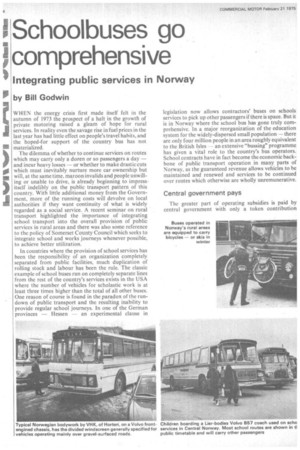Schoolbuses go comprehensive
Page 46

Page 47

If you've noticed an error in this article please click here to report it so we can fix it.
Integrating public services in Norway
by Bill Godwin
WHEN the energy crisis first made itself felt in the autumn of 1973 the prospect of a halt in the growth of private motoring raised a gleam of hope for rural services. In reality even the savage rise in fuel prices in the last year has had little effect on people's travel habits, and the hoped-for support of the country bus has not materialized.
The dilemma of whether to continue services on routes which may carry only a dozen or so passengers a day — and incur heavy losses — or whether to make drastic cuts which must inevitably nurture more car ownership but will, at the same time, maroon invalids and people unwilling or unable to drive, is already beginning to impress, itself indelibly on the public transport pattern of this country. With little additional money from the Government, more of the running costs will devolve on local authorities if they want continuity of what is widely regarded as a social service. A recent seminar on rural transport highlighted the importance of integrating school transport into the overall provision of public services in rural areas and there was also some reference to the policy of Somerset County Council which seeks to integrate school and works journeys whenever possible, to achieve better utilization.
In countries where the provision of school services has been the responsibility of an organization completely separated from public facilities, much duplication of rolling stock and labour has been the rule. The classic example of school buses run on completely separate lines from the rest of the country's services exists in the USA where the number of vehicles for scholastic work is at least three times higher than the total of all other buses. One reason of course is found in the paradox of the rundown of public transport and the resulting inability to provide regular school journeys. In one of the German provinces — Hessen — an experimental clause in legislation now allows contractors' buses on schools services to pick up other passengers if there is space. But it is in Norway where the school bus has gone truly comprehensive. In a major reorganization of the education system for the widely-dispersed small population — there are only four million people in an area roughly equivalent to the British Isles — an extensive "bussing" programme has given a vital role to the country's bus operators. School contracts have in fact become the economic backbone of public transport operation in many parts of Norway, as the guaranteed revenue allows vehicles to be maintained and renewed and services to be continued over routes which otherwise are wholly unremunerative.
Central government pays
The greater part of operating subsidies is paid by central government with only a token contribution coming from the provinces or municipalities. The receipt of subsidies does not, however, keep all operators out of the red and deficits are made up by the state and local authorities. In one typical operating group formed about two years ago in the central province of Hedmark the income from school work is over 100 per cent greater than that derived from cash fares, tours and works services although for the whole of the country school contracts provide just over half the income of the national bus revenue, including mail and parcels receipts.
What is unique about Norway is that most school services are shown in the public timetable which in turn reflects the alignment to the school day, with journeys from outlying areas in the morning and return trips in the early afternoon. Some journeys may take children 60 or 70 km to the nearest school town and back and the vehicles used have an exceptionally high degree of comfort. Spending so much time on the road means that features like double-glazing, heavy-duty heaters, tape players and radios are essentials rather than luxuries. To enable passengers to cover the sometimes not inconsiderable distances between their home and the bus stop by hike and then to take it along many of the buses possess front-mounted carriers. Vehicles also carry spare wheels to lessen the dependence on outside aid in the more isolated parts of the country.
During the winter roads used by school buses are cleared as a first priority. By law each psv must carry snow chains but these are now rarely used. The use of spikes in winter tread tyres is becoming popular and these are usually fitted on front and driving axles for the full term of the permitted period, i.e. mid-October until early in May.
faxation hub
Vehicle taxation is based on distance travelled and accordingly all buses are fitted with a hub-mounted odometer which is "read" quarterly by the police. The current rate is 14 Ore per km (approx 11/4 new pence). There is little or no market for second-hand buses in Norway — a special tax is payable on transfer by the new owner — and, in general, units remain with one operator until repairs and maintenance to the required high standard are no longer economic.
Volvo continues to top the list of makes in use by Norwegian operators. The strength of Volvo's reputa:ion is backed up by the reassuring proximity of the riothenburg plant. heavy duties preclude the import of 'ully built-up vehicles and the construction of psv bodyvork is now shared by three firms. Foremost among these s VBK (Vestfold Bil & Karosseri) of Horten.












































































































